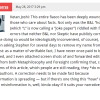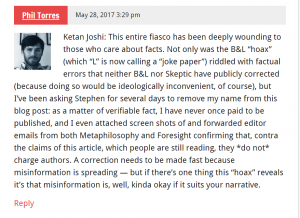The second top story under “trump administration epa” – Rule to limit mercury and arsenic in waterways is delayed by the EPA.
Naturally. Let’s not be hasty about keeping mercury and arsenic out of waterways…in fact let’s not do it at all. People can always drink bottled water.
The Environmental Protection Agency would like to delay an Obama-era rule that limits the amount of toxins power plant operators can dump into waterways, the agency announced late last week.
In a new rule, expected to be published this week in the Federal Register, the agency has proposed delaying the compliance dates of the 2015 Steam Electric Power Generating Effluent Guidelines until the EPA reviews them.
Environmental groups characterized the EPA’s decision to delay implementation of the rule as in line with the Trump administration’s attempt to conduct a broad rollback of regulations designed to protect public health. The Obama administration estimated that the 2015 rule would keep 1.4 billion pounds of toxic metals and other pollutants out of waterways each year.
Who is most likely to be poisoned by this move? The people Trump claims to love and want to help, that’s who. The people who don’t live in leafy suburbs with good water treatment systems.
EPA Administrator Scott Pruitt said the proposed delay, if finalized, will give the administration time to “carefully consider the next steps for this regulation.” He also touted the decision as one of nearly two dozen “regulatory reform” actions that he has taken during his brief tenure as EPA administrator. The decision is designed “to protect the environment, jobs and affordable, reliable energy,” he said in a May 25 statement.
Then he lied, since the decision is obviously designed not to protect the environment.
These people are like evil villains out of fairy tales.
In an earlier press release announcing his decision to reconsider the final rule, Pruitt said “some of our nation’s largest job producers have objected to this rule, saying the requirements set by the Obama administration are not economically or technologically feasible within the proscribed [sic] timeframe.”
“Job producers” is of course Republican code for corporations and shareholders. They produce as few jobs as they possibly can, because jobs cost them money.
The protections targeted steam electric power plants — which often run on coal— that dump large amounts of toxic pollutants into streams every year.
Electric plants dump 64,400 pounds of lead, 2,820 pounds of mercury, 79,200 pounds of arsenic, and 1,970,000 pounds of aluminum into the country’s waterways every year. Some of these pollutants, including arsenic, are known carcinogens, while others, such as lead, have been linked to developmental and reproductive problems. This pollution has also been linked to fish die-offs, the EPA explained in 2015.
Nobody wants to eat fish anyway. Just get a Big Mac.







